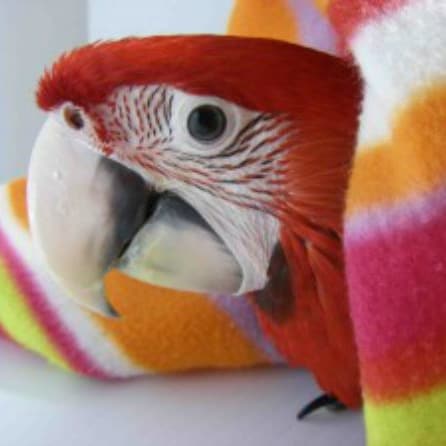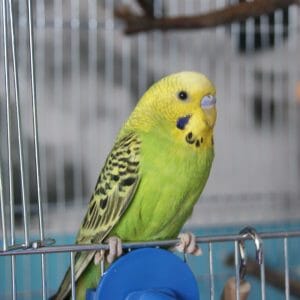Last Updated on by Mitch Rezman
Michael G. relates:
I have a mystery! I have two African Greys.
But first, a bit of history.
They are in a large cage 3′ deep, 6′ high, and 5′ long.
I rehomed them after 18 and 20 years with the female the oldest and banded while the male doesn’t have a band.
She is pretty docile while he, after 2 years is still a bit afraid and likes to bite when she is startled.
They are both flighted as I have never trimmed their feathers although I live in a townhome and they can’t fly too far but do it well when they are out.
I feed them Roudybush pellets and discontinued the powder to liquid at Roudybush’s instruction as they say the pellets supply all they need.
I also mix in Zupreem NutBlend, VeggieBlend, and Fruit pellets.
They get a peanut right off the bat in the morning and one for a bedtime snack.
He attacks them while she will sometimes turn down the morning peanut.
I use Higgins Safflowergold and Hagen Tropimix as seed food along with pumpkin seeds, slivered almonds, (won’t touch a whole one!), pistachios, pine nuts, and other seeds.
I buy the large bag of safflower seeds at Kroger to “stretch” their seed diet.
At around 3 o’clock, and, yes, they have an internal clock as they let me know it is 3 o’clock in their world, I feed them a combination of broccoli, carrots, radishes, sweet potato, apple, and other fresh veggies.
I came about these feeding choices by paying attention to what I supplied, what was left after feeding, and what was “slung out”, ha!
Her favorite is broccoli and carrot while he is a “sampler” and likes it all.
I found, after discarding it, that the broccoli stalks are something he especially likes so I split them longways and cut them into 1 1/2 to 2″ inch pieces.
She loves me while he is attracted to my girlfriend.
Admittedly, Amy thinks it is cute to feed them “junk” and, naturally, they love it!
She gives them “goldfish”, sesame sticks, popcorn, cheez-its, and oriental rice blend, etc.
I’ve tried to discourage this but I am outvoted 3-1, ha!
When out of the cage he is still a bit skittish but will get on my finger/hand when I present it.
I have to walk cautiously or he will flap his wings and want to fly away but he does NOT bite out of the cage.
I suspect this is due to his “alpha male” dominance to protect HER and his HOME.
If I attempt to pick her up from the cage he races over to try and discourage me from letting her on my finger!
They get plenty of sunlight and “daylight” artificial lighting.
I bought a bulb from you and will use it when the days are shorter.
They sometimes don’t get ALL the nighttime dark that is recommended.
I turn the lights out in OUR room but sometimes stay up a bit later and they have their “dark” with maybe a TV playing in the next room.
Their cage is next to my desk in the “office” so we interact throughout the day although they get real quiet at times for their “nap”, I suppose.
They have picked up a lot of words and phrases along the way.
He is more vocal although she and I have certain whistles we can communicate with like a “bobwhite” call and other whistles we each know as our own.
So, Greys don’t get too old to learn!
Okay, the history is mostly complete except that they love to taunt Maggie Mae, my half basset-beagle”!
They have even lured her into range to peck her big, ole black nose or grab an ear.
It doesn’t hurt but Mag is PO’ed that they trick her!
The birds LOVE music and to dance with AMY!
She moves around to the beat and, yes, they have songs they like better than others just like WE do.
Their intelligence and cognitive skills are amazing and it is fun to see them expand their knowledge.
They were in this large cage on an enclosed patio environment.
They did NOT SEEM too happy as she would stay in a nesting box while he “guarded” it.
There was ONE incandescent 60-watt bulb above the cage and they got very little sunlight.
Their diet was of a cheap Walmart seed blend with a good bit of sunflower seed.
Mystery one!
I brought her home first a week before him and had her in a cage my deceased white cap Pionus had.
I didn’t notice any unusual behavior as she loved getting out.
I’m pretty sure they had not been out of the cage in 3 years.
She seemed happy especially when I brought him home.
I can’t pinpoint when but she began plucking her chest feathers and even created small scabs.
Occasionally. I’d find wing feathers but never a red tail feather.
She plucked her chest clean as a whistle down to the skin.
Mystery Two – It seemed like overnight but I looked at her one day and she had grown ALL the feathers back and is hard to tell from him other than the band, if visible, and mannerisms.
Bottom line – I don’t know what I did or what changed to prompt her to quit plucking.
I guess if I knew I could proclaim myself a bird psychologist and make a bunch of money!
Thanks for listening.
ANY IDEAS?
That’s a remarkable story, Michael.
Of course, I have ideas, lot’s good and sometimes a few not-so-good.
Let me start off by saying you take very good care of your birds.
You keep them flighted and they are on a great diet!
We will start off with some housekeeping.
The human food your girlfriend is offering will be fine and it helps submit a relationship within the flock.
You want to watch for too much salt.
Your birds are a pretty good size so a few human morsels of salty coated snacks won’t impact them like that same amount would affect a cockatiel.
Salt has the potential to disrupt a bird’s electrolyte balance.
Signs to look out for are dehydration, excessive thirst, kidney dysfunction (something only a veterinarian could confirm) with the worst-case scenario ~ death.
Re: “ I bought a bulb from you and will use it when the days are shorter. “
Lighting should be employed daily 12 months a year no higher than 6 inches above the cage.
link “wrong” The light should be placed in a timer set for 12 hours of light and 12 hours of darkness all year round.
Relying upon natural sunlight is a stressor because sunup and sunset are moving targets in North America year-round.
Stressors will inevitably result in feather destruction, especially in greys.
Now I’m going to give you something you can hang the wash on.
I think your bird was plucking but she was molting.
African grays have an unusual molting pattern.
Most birds molt once or twice a year (remember I said that)
A molt is when a bird loses all its feathers and replaces them with new ones.
This can be 3000 to 4000 feathers in a small bird.
5000 to 7000 feathers can be found on a parrot.
Ducks, swans, and geese can have from 10,000 to 15,000 feathers covering their body which enables them to swim in ice-cold water.
Molts occur symmetrically.
When a particular feather is lost on one side of the body, the identical feather on the other side of the body will drop off as well.
Most pet bird keepers underestimate the tremendous caloric strain molting places upon a bird.
Add a breeding hen whose body is trying to produce eggs on top of a molt, and you have a bird whose every resource has been weakened including their immune system.
Protein-rich foods like kale and eggs do not come close to supplying enough protein.
Feathers are generated from amino acids which are derived from protein.
Mature feathers are similar to a mammal’s hair and nails.
They can be trimmed with no pain because they have no nerves.
Growing feathers however have blood in the shaft while in development which is why they are called blood feathers when they break.
Barney, our cockatiel, is just learning how to fly (after a quick clip and has an affinity for flying into our window blinds.
This results in a broken tail feather now and then.
If it’s an old feather we cut it off at the break.
If we see blood we pull it out at the shaft.
Read more about molting here:
Re: Most birds molt once or twice a year (remember?)
African grays have a different instinctual molting schedule.
They can molt continuously for up to two years.
How And Some Of The Why’s African Greys Molt Differently Than Other Parrots
Normally because of the current coin shortage, I have been unable to add my two cents, but I make exceptions when it comes to pet bird behavior.
Without pictures of the bird and its environment and no medical or nutritional history to draw from I’m going to “guess” we’re looking at a molting situation.
In order to stay on top of things, I would examine her chest feathers regularly checking for scabs or any other signs of self-mutilation.
Please keep in touch and let us know how this plays out.
Stay safe
Best
MitchR.
Comment Added 10/8/2020.
I also suspect the nesting box.
Some females will pluck their breasts to have skin contact with their eggs.
It keeps them warmer.
I’m not 100% sure about greys, but most of us keep them in a cooler climate than their native habitats.
Also, greys need intellectual stimulation. Boredom could certainly lead to plucking.
Just a couple more thoughts.
—Linda.
Author Profile
Latest entries
 The Traveling BirdJune 26, 2025Can You Name 5 Parrot Species That Are Living Wild in the USA?
The Traveling BirdJune 26, 2025Can You Name 5 Parrot Species That Are Living Wild in the USA? Bird BehaviorJune 26, 2025How is it Parrots Are Problem Solvers Social Animals and Even Use Tools?
Bird BehaviorJune 26, 2025How is it Parrots Are Problem Solvers Social Animals and Even Use Tools? Bird & Parrot AnatomyJune 25, 2025How a Tiny Chemical Modification Makes Parrots Nature’s Living Paintings
Bird & Parrot AnatomyJune 25, 2025How a Tiny Chemical Modification Makes Parrots Nature’s Living Paintings PigeonsJune 20, 2025How Do Parrots Thrive in Cities Outside Their Native Habitats?
PigeonsJune 20, 2025How Do Parrots Thrive in Cities Outside Their Native Habitats?




